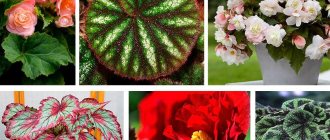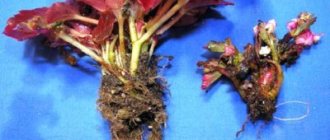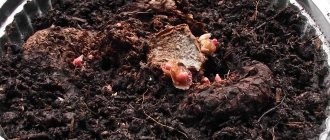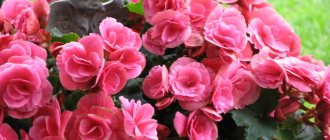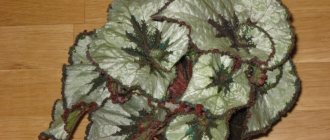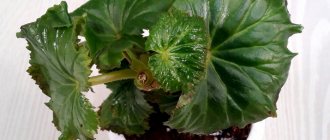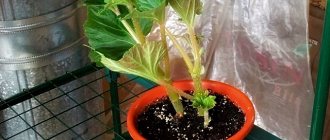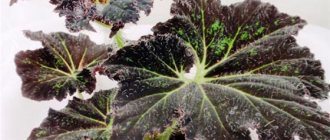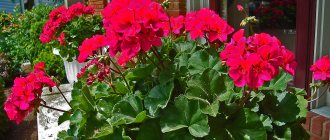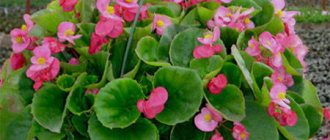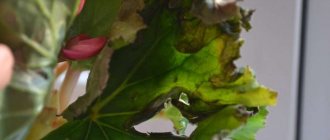The majestic begonia (one of the varieties was not called royal for nothing) is a unique flower. One of the few tropical plants, the species of which combine several different classes, begonia can climb like a vine, grow as a bush or a small leafy cap, and delight the eye with a variety of colors of buds or foliage. All this is begonia. Care at home - the photos speak for themselves: the flower is incredibly beautiful.
Begonia bush.
Begonia creeper.
Begonia blooming.
Begonia leaves.
Together with the portal agronom.guru, we will learn more about this exotic guest, talk about caring for the plant, the characteristics of begonia propagation, analyze the difficulties that can arise with improper care, and study the varieties of the flower with photos and names. The homeland of begonia is the hot tropics, or rather the Antilles. The plant was first found and described by the French biologist Charles Plumier in 1687. However, the exotic flower received its name thanks to the “sponsor” of the expedition, Michel Begon.
The Antilles - the birthplace of begonia
The main feature is abundant flowering all year round. Begonias “fall asleep” for a short time. And young plants with still unripe tubers can generally “boycott” the regime of winter sleep and rest.
Begonia is very popular among breeders. So much so that there are twice as many hybrid forms as decorative varieties. Of the three thousand known flower variations, two are hybrids.
They thrive in damp, shady places – in rock crevices and tree roots. Distributed in the subtropics of America, Southeast Asia and Madagascar and Hawaii.
Begonia in Hawaii.
There are types of flowers that are not afraid even of salt water. In the Philippines, begonias do well on limestone cliffs. In the Andes and Himalayas they can grow high above sea level. There are also succulent forms that absorb water into the tubers. There are artificially grown ones, for example, this begonia is shaped like a Japanese bonsai tree.
Begonia Bonsai Schmidt.
Home care
Basic principles of caring for a green pet:
- timely watering;
- introduction of microelements;
- required temperature and humidity;
- rejuvenation.
Location and lighting
Initially, decide where the tiger flower pot will be placed. Windows facing southeast or southwest are suitable. It is better to provide diffused lighting, as direct rays of the sun can cause burns. Keeping environment within +18 degrees.
Watering
Proper care is all that is required for any indoor plant. Watering in this matter occupies, perhaps, a leading position.
Distribute the moisture evenly and abundantly over the entire area of the flowerpot. In dry and sunny weather, it is acceptable to place the flowerpot in a bowl with moistened gravel or moss.
Intensity of moisture application in summer: 1 time every 2-4 days. It is better to do this in the morning or evening, preferably at the same time. With the beginning of autumn, gradually reduce watering. And in winter, reduce it to a minimum: once every 6-8 days. If the soil is completely dry, lower the pot into water, and the soil will be saturated with moisture through the drainage.
Temperature
Changes from warm to cold are undesirable. The best conditions for begonia: from +18°C to +20°C. During the rest period +15°C.
Air humidity
Prefers high humidity. It is desirable to create the effect of moisture evaporation. To do this, place the flowerpot in a bowl with moistened moss or pebbles. But getting moisture on decorative leaves is undesirable. Unusual spots may appear. If it is not possible to use a tray, increase the air humidity with a spray bottle or a special humidifier.
The soil
Bauer's begonia prefers to grow in a nutrient medium with the following composition:
- 50% leaf soil;
- 20% peat;
- 20% black soil;
- 10% river sand.
The formation of the soil composition requires a certain sequence:
- first lay a layer of washed sand;
- Fill half the volume with leaf soil;
- the rest is peat and black soil.
Feeding and fertilizers
It is to improve the growth of tiger flower leaves that nitrogen-containing additives need to be used:
- "Kemira";
- "Uniflor-growth";
- "Agricola".
Transfer
The condition is mandatory to fulfill. The roots hanging from the drainage holes will indicate that it is time to increase the volume of the flowerpot. Standard procedure:
- choose large container sizes;
- create drainage;
- remove from the previous container;
- clean the roots;
- cut off damaged ones;
- disinfect with potassium permanganate;
- drop off in a new place;
- fill the pot with soil mixture;
- water.
You need to carry out this procedure when you bought a bush, and then once a year.
Trimming
Question: is pruning necessary? The answer is yes. It should be done in the early stages of growth, following some rules after the procedure:
- Reduce watering to speed up growth.
- Shorten the sprout when it reaches 8-10 centimeters (necessarily above the bud).
- Stop pruning in a timely manner when the flower has acquired the shape you want, and remove only the largest and most dried stems.
Factors indicating the need for pruning:
- leafy shoots are removed;
- the appearance of dried or broken sprouts;
- creating a beautiful shape;
- before the start of winter.
Crown formation
Decoration of begonia is carried out while it is growing - in the summer. If you are in a room, you can, in principle, prune it in winter. But at the same time, pay attention to timely hydration, temperature conditions, lighting, and the addition of minerals. Decorative effect is achieved by pruning and pinching.
Sunday, June 15, 2014
At first glance, this advice seems strange, because they usually warn that excessive deepening of the stems should not be allowed, and excessive exposure of the root collar is also unacceptable. The reason for deep planting is to bury more stem buds, which will later produce many new stems and also cause more roots to form in the buried parts.
Indoor cane begonias can be pruned at any time of the year.
If cane begonias do not grow indoors, then pruning is done in the spring.
If you do not want to intentionally grow a tall, large specimen, then pruning is required. In addition, pruning encourages the growth of young, new shoots. And in cane begonias that have not been pruned, there is a tendency for the stems to become bare in the lower part. Superba types should be pruned in the spring and more severely than other types of begonias. During the rest of the year, the Superba type is allowed to freely increase its green mass.
Pruning promotes branching, the plants become lush and beautiful.
Reed begonias should only be watered when the surface of the soil in the pot becomes dry.
During the growth period, cane begonias are fertilized every week. But cane begonias can only absorb a quarter of the fertilizer given to them.
Most cane begonias will not bloom well if the lighting is poor.
If the weather is hot, the temperature is high, or begonias grow in a hot climate, then they can “burn out,” that is, get serious burns. Especially if you are standing in direct sun late in the day (the hottest time of the day). It is enough to shade them with openwork tulle or white paper. But the further south they are grown, the more serious shading may be needed. But in climatic zones where it is not cold in winter, there are no frosts, cane begonias will calmly spend the winter in the open air without protection.
Many begonias suffer from drooping leaves during cold weather. This is normal unless caused by disease, overwatering or pests.
With a sharp change in temperature, cane begonias are also prone to drooping leaves, or they seem to droop down. This is fine. They quickly recover under normal conditions.
Pests and diseases:
The annual pruning I mentioned above also helps get rid of pests.
Insecticides should be used to control these pests, and not traditional methods, otherwise the plants will quickly die.
Many insecticides work well against aphids. Strong sprays of water also help to wash off aphids from plants, but usually you still have to use additional insecticides.
Cane begonias are also prone to botrytis (gray mold), especially during cool, wet weather. Leaves and stems droop, leaf rot begins from the petiole. Removing damaged leaves from healthy begonias and collecting fallen leaves help prevent the disease to a certain extent. Sick begonias should be treated only with fungicides.
Source
Bloom
Interest and curiosity is aroused by the fact that begonia flowers have different sexes - male and female. They can be distinguished by the following characteristics:
- in females there is a small growth on the bottom where a box with seeds will appear;
- the male one does not have it, and his flowers are double, although not always.
During this period, it is necessary to intensively water the blooming beauty, providing access to the sun and microelements.
Begonia - brief botanical information
By type, begonias can be divided into annual and perennial. Plants are so diverse that it is impossible to describe all its characteristics. However, there are some features common to all begonias:
- leaf asymmetry;
Royal begonia leaf.
- bright flowers : white, yellow, red, pink, edging possible;
In terms of beauty and richness of its buds, begonia can compete even with the queen of flowers - the rose.
- the fruits , if not removed, have the shape of a box. In nature, this is how a plant reproduces - the film bursts and the seeds are carried away by the wind.
The seeds of some types of begonia are extremely small - there can be up to 75 thousand of them in one gram.
There are many types of begonia. There are evergreen varieties, there are deciduous, perennial and annual, outdoor and indoor, creeping and tall. In floriculture, the following classification is usually used: decorative deciduous and flowering. Types of indoor begonias, photos with names, let's look at them right now.
Reproduction
There are enough ways to get young individuals. The main thing is to decide which one to choose and focus only on it. You can work in this regard all year round at a time convenient for you:
- leaf;
- cuttings;
- seeds;
- dividing the root.
Leaves
Rooting with a single leaf is possible. To do this, take a healthy leaf from the plant and cut several segments. The main thing is that it has at least one vein. Stick it into the ground to a depth of one centimeter or spread the material on its surface, sprinkling the ends with earth.
Water intensively, covering the top with glass or film. Provide access to light and heat. In about a month, sprouts will appear.
Cuttings
Perhaps the easiest and fastest way to get new material. A stem is taken, cut into pieces with one or two buds and rooted in water or soil.
It is better to make a cut where the leaf grows, that is, a node, on an oblique, leaving half of the leaf. If the cutting is in water, do not drain the water, adding new water as needed. Until roots form, keep the container warm up to +26 degrees. Rooted cuttings are planted in the ground.
Seeds
The process is possible, but it requires patience and time. Begonia seeds are very small and difficult to sow. The sprouts are also delicate and require special care. But if you still decide, choose the most suitable period for sowing - January or February.
Cover the container with seeds with glass. Water and ventilate regularly. After the sprouts appear, transplant into separate small containers. Keep them covered at first, but gradually get used to their surroundings.
By division
The rhizome is divided into several parts and transplanted into separate pots. Cover the top with film or glass. The upper part should not be covered with earth. With proper care, sprouts will appear in 2-3 weeks.
Special watering rules
Water for irrigation should settle and have a temperature slightly above room temperature. When watering with cold water or high soil moisture, the roots will deteriorate. House begonia loves moderately moist soil.
It is not recommended to pour leaves and flowers during watering. It is better to water along the edge of the pot. In summer, watering is done once a week, and in winter - once every ten days.
Care errors
Unconscious love for plants can lead to unintentional actions towards them. And begonia is no exception. Some actions are undesirable and at times even harmful:
- crowded flowerpots;
- planting in a large container, as if “for growth”;
- the amount of moisture should not exceed the needs of the flower;
- You cannot use a substrate that does not meet the acidity, density and presence of microelements required for this plant;
- violation of the dosage of fertilizer application;
- failure to prepare and care when the dormant period begins;
- improper use of poisons in the treatment of diseases.
Humidity
Begonia loves moist air, but this does not apply to moisture on the leaves. Traditional spraying often results in spots on begonia leaves. Therefore, if you still armed yourself with a spray bottle, spray it into the air next to the plant, but not on the leaves.
Begonia owners are saved by a life hack with a second, larger tray, into which a little water is constantly added to evaporate from the resulting “mini-lake.”
Tip for the winter: if the radiator is nearby, you can hang a wet cloth on it, creating begonia memories of their native tropical climate.
See also:
- How to care for dracaena at home
- Anthurium - home care guide
- How to care for a money tree (crassula)
- Caring for indoor hydrangea at home
- How to care for myrtle at home
- How to care for hibiscus (indoor Chinese rose) at home
- Caring for Zamioculcas (dollar tree) at home
- How to care for Kalanchoe at home
- Tree in the room: how to care for Ficus Benjamin at home
- How to care for geraniums at home - a guide for beginners
- How to care for orchids - 7 steps for a beginner
- How to care for violets at home
- How to care for Schefflera at home
Folk signs
Human word of mouth spreads information about the benefits or harms of house plants better than any advertising. The literature also describes signs and superstitions associated with flowers. Let everyone decide for themselves whether to believe them or not, but it is advisable to know about it.
What begonia can offer:
- Takes on negative energy.
- Increases decisiveness in making responsible decisions and activity in action.
- Brings peace and harmony to the home.
- Rapid growth and abundant flowering - good luck awaits you.
- Unplanned flowering is a new addition to the family.
- Withering will bring misfortune.
Illumination
Over the years of selection, begonias have settled in city apartments and grow quite well even on northern balconies. Their main “requirements” are the absolute golden mean: bright diffused light, not scorching direct rays, but not a room without windows. Important: the brighter the color of the leaves and the more magnificent the flowering, the more light the plant needs. Begonia feels best on eastern and western windows.
Medicinal properties
In folk medicine, begonia is used to treat:
- Alcoholism. The use of the decoction causes gag reflexes followed by aversion to alcohol. Treatment is carried out by adding the medicine to the patient’s food or drinks.
- Melancholy. The flower is useful for people who take everything to heart with or without reason.
- Depression. Has a positive effect Being in a room where flowers are present gives amazing results.
Observations record: begonia can be used as an absorber, concentrating all negative energy. This is a great gift for people with emotional and mental disabilities.
How to plant indoor begonia in a flower pot
A special soil has been developed and sold for begonias, but you can make a soil mixture yourself - you just need to know a few tricks.
Soil requirements
There are several options for preparing soil:
- leaf soil and peat in equal mass ratios;
- sand taken half as much as these components.
In another case, the composition is more diverse:
- peat, humus and sand in equal quantities;
- deciduous soil taken in three times the amount.
Also read: Fitosporin-M: instructions for use of paste, powder and liquid preparation
And another option:
- equal parts of leaf, coniferous soil and sand;
- charcoal - 2-3 pinches.
Important! When making your own mixture, you always need to disinfect the soil - you can simply treat it in the oven for an hour or boil it for half an hour.
A special soil has been developed and sold for begonias.
Landing technology
The flower is grown from tubers (bulbs). They should be purchased in winter, since planting takes place at the very beginning of spring - then you can have time to grow begonia, which will bloom in the summer.
The landing technology is as follows:
- Tubers must be carefully cleaned of foreign bodies and wilted rhizomes.
- Soak in a weak solution of potassium permanganate or a special disinfectant for half an hour.
- Plant in soil prepared as described above. The soil should be well loosened.
As for the pot, it is chosen to be small in size so that the boundaries from the tuber to the edges of the pot are no more than 5 cm.
Important! Soil drainage is a prerequisite for any variety of begonia. You can use small pebbles or expanded clay, which are poured to a third of the depth of the dish.
Begonia is grown from tubers
Kinds
The most common:
- Fuchsia. Height up to 1 meter, large, green, shiny leaves.
- Tuberous. Large rhizome, transparent stem up to 80 centimeters, double inflorescences.
- Picoti Harlequin. Height is about 25 centimeters, yellow flowers with double edges, green leaves with teeth.
- Bouton de Rose. A wide variety of colors - from white to pink. The leaf is large with wavy edges.
- Ampelnaya. Elongated cascading stems, bright flowers.
As you already understand, begonia is a striking and distinctive plant. She is glamorous, but with character. Everyone will find something interesting and unusual in the flower to decorate the interior of their home.
Heat-loving and afraid of drafts
Begonias are great lovers of heat. The most favorable temperature for them is from twenty to twenty-three degrees in the summer. Exceeding the temperature regime is unacceptable. The plant may dry out.
In winter it should not be lower than fourteen degrees. In winter, you need to ensure that the temperature of the soil in the pot and the temperature of the leaves of the plant are approximately the same.
The flower should not be allowed to stand on the windowsill and be blown from below by heated air from the heating radiator. This can lead to the death of the plant.
